This post and the photos within it may contain affiliate links. If you purchase something through the link, I may receive a commission at no extra charge to you.
Blackletter calligraphy is one of many scripts created using a broad-edged nib, and my friend Edgar is going to share the very fundamentals and how to get started step-by-step.
On top of that, Edgar has also prepared FREE practice sheets, including both capitals and lowercase letters – but more on that later on!
Hello everybody,
My name is Edgar Villa. A few of you may know me by my social media handle, ‘Made by Edgar,’ and I am a Mexican calligrapher/artist from Jersey City.
I composed this article to help beginners interested in learning ‘Blackletter’ calligraphy.
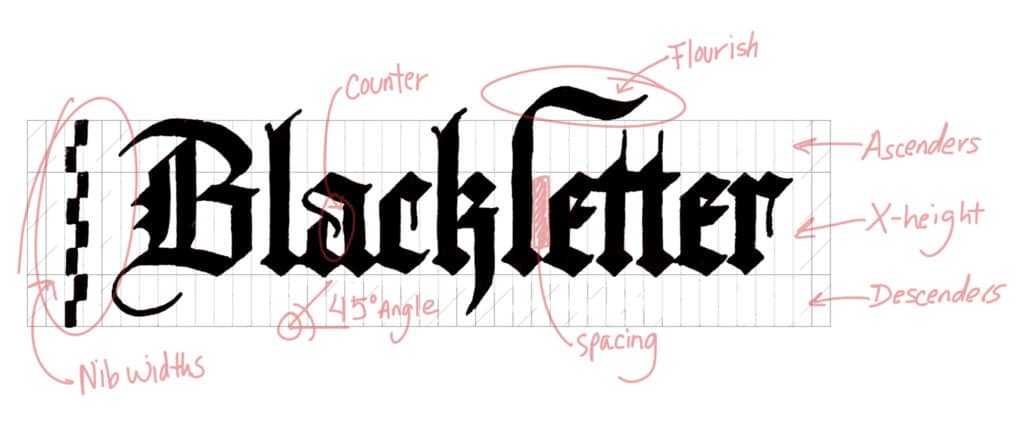
This blackletter tutorial will teach you these 6 things;
- Origins of Blackletter
- The tools needed to begin
- How to use your tools to get the best results
- How to use guidelines for perfect letters every time
- Understanding basic letterforms
- Basic flourishing
Let’s get started!
Origins of Blackletter
Blackletter, also known as ‘Gothic,’ was created during the 12th century at a time when more and more people began to read and write. The demand for books where increasing, and they had to be written fast to meet that demand.
Blackletter’s condensed written style made it so more words fit on a single page, and thus less vellum was used, which lowered production costs.
In short, Blackletter made producing a large number of books easier and more affordable.
Blackletter has many variations Fraktur, Rotunda, and Schwabacher, to name a few. Since Blackletter has a wide family of scripts, I will narrow it down and help you grasp the basics of a script known as ‘Textura Quadrata’.
Tools Needed for Blackletter Calligraphy
To learn blackletter calligraphy, you’ll need basic calligraphy tools.
However, I made my own recommendation here below.

- Broad edge nib
- Pilot parallel pens are my favorite because they are ready to use out of the box
- Any broad-edge nib
2. Straight holder
3. Paper that doesn’t bleed
4. Calligraphy Ink
- Dr. Ph. Martin’s India Inks
- Moon Palace Sumi Ink
- Winsor & Newton Gouache
- Or any ink meant for calligraphy purposes
5. Water and paper towel to clean nibs
- You can also use a cloth/rag, preferably a non-fibrous cloth
6. Ruler
- I use a ‘rolling ruler’ because it helps me make even horizontal and vertical lines with ease
- A regular ruler will work just as fine
7. Pencils
- 4H-HB pencils are recommended because any heavier graphite will make it hard to erase
8. Eraser
- A kneaded eraser is perfect, but any eraser will do
The paper you choose for your calligraphy matters!
From day one, I used Rhodia’s paper; here are two big reasons why you should too;
- The ink doesn’t bleed.
- You have the option of getting the paper lined or dotted, which makes it easier to create straight lines that are required for Blackletter.
For any piece that I will hang on my wall, I will use the best paper I can get my hands on
But for calligraphy practice, any low-quality paper works.
How to use your calligraphy tools
Like any tool, be it woodworking or sculpting, each tool has a purpose, and there are ways to maximize the effectiveness of each tool.
Broad Edge Nib
If you are using a broad-edge nib, there is a good chance you may need to ‘prepare the nib’ before you even use it.
When you purchase a new nib, it comes with a protective coating that keeps it from rusting while held in storage. That protective coating, tho important, works against you when you dip the nib in ink.
If you do not prepare your nib for writing, the ink will not stick to the nib properly. You will also have ink blob up when you write, or you will need to re-dip the nib every few strokes.
Here are 4 ways to ‘Prepare A Nib’:
- Clean the nib with a toothbrush and toothpaste under warm water
- Stick the nib CAREFULLY into a potato for a few minutes
- Use a bit of your saliva on the nib and clean it with some paper towels
- Put the nib over a light flame
- Using fire is very dangerous, and I am not responsible for any harm brought to you or others. Use caution and be very careful. This method may also ruin your nib if left for too long over the flame. I don’t recommend this to any beginner. Try at your own risk.
There are two ways to load ink into a broad-edge nib, you either dip the pen in ink or fill the reservoir using a brush.
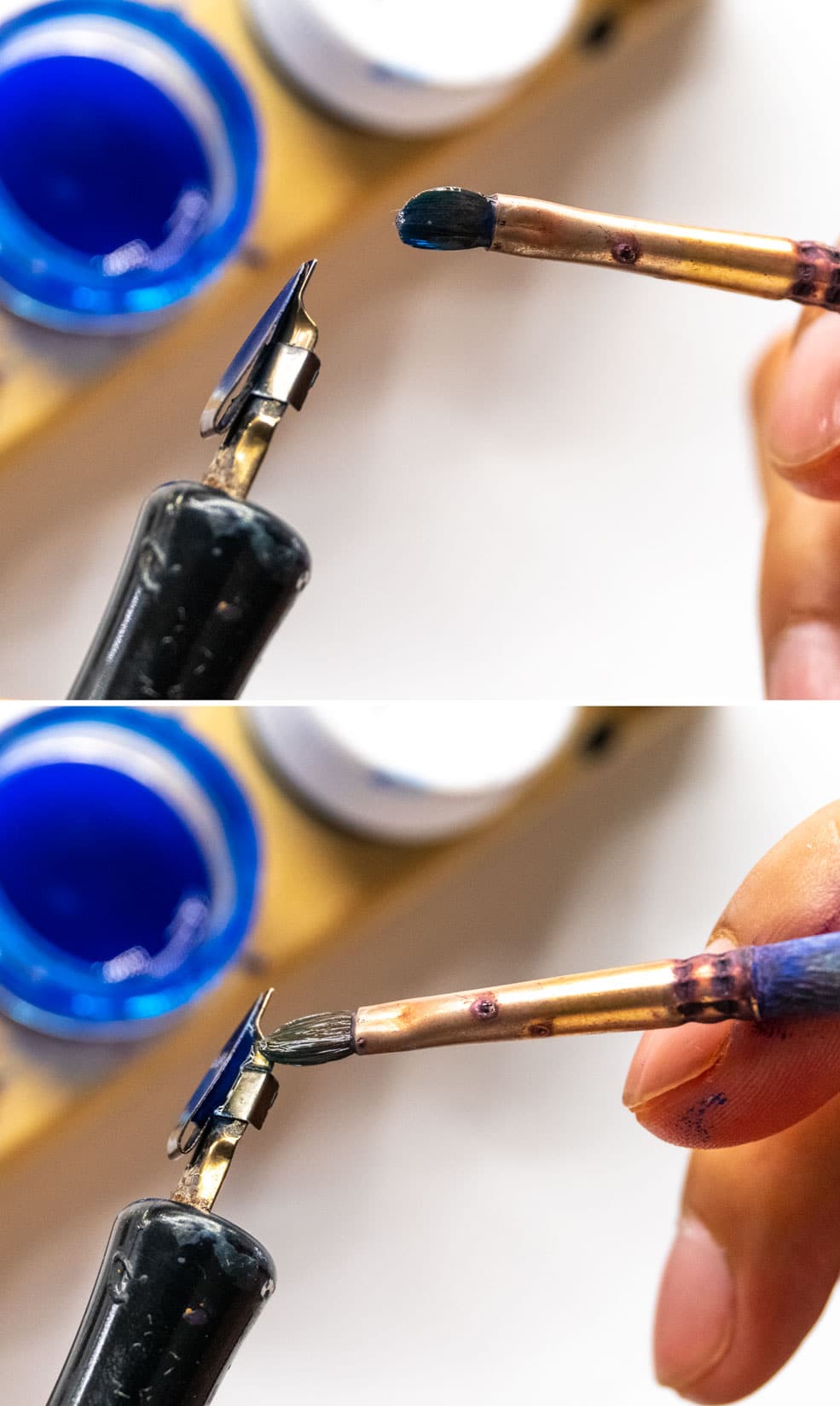
*Some broad-edge nibs do not come with reservoirs and need to be dipped for the best results
If you dip the nib, make sure you let any excess ink on the nib pour back into the ink bottle. If you have too much ink on the nib, it will blob when making strokes.
Furthermore, a low amount of ink will have you dipping your nib into ink every few strokes.
If the ink on the nib begins to dry into goo, be sure to clean the nib with water and a rag to remove any dried-up ink.
You can also remove the reservoir to give the nib a deeper clean. *remove the reservoir CAREFULLY because it’s VERY FRAGILE. Also, to avoid breaking the reservoir, you can get in hard-to-reach places with a toothbrush*
Pilot Parallel Pen
This pen is ready to use and beginner friendly. The main tip for using this pen is to apply even pressure to get the best results. Too much pressure on the left side will make the right side of the stroke choppy and vice-versa.
I highly recommend you use Pilot brand cartridges ONLY.
When changing the ink cartridge, make sure you clean the pen so the previous ink color doesn’t mix with the new one and give you a color you may not want.
Let’s get started! – Guidelines
When I start a new project, I will use guidelines even in the sketching phase. The guides help me keep all my letters even and consistent.
Textura Quadrata typically requires 4-5 nib widths for the x-height and 6-7 nib widths for the ascenders and descenders.
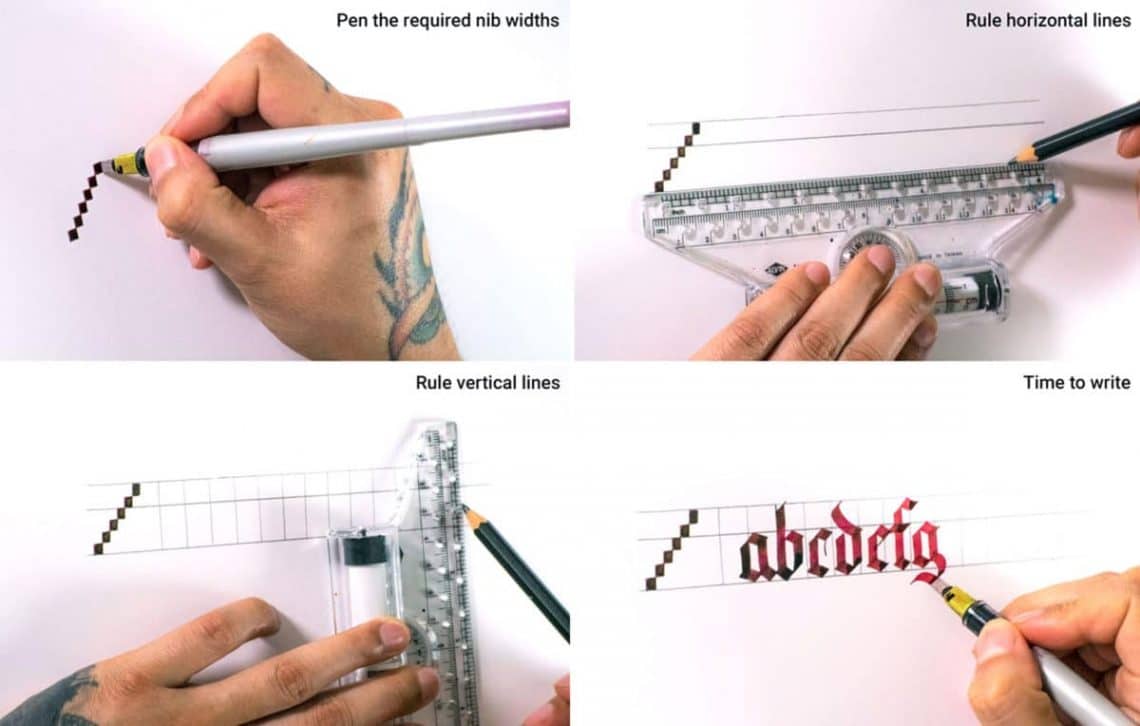
I rule horizontal lines to keep my letter the same height and rule vertical lines to keep my vertical strokes as straight as possible.
Don’t be afraid to try something new.
You don’t have to stick to the 4 and 6-nib width spacing; mix it up and try different letter weights.
Remember, rules are meant to be broken.
Understanding basic letterforms and spacing
If you look at any manuscript written in Textura Quadrata, you will notice dense and heavy strokes, giving it a dark overall feel.
Straight vertical lines and tight spacing is what give Textura Quadrata its unique style.
Set aside some time to focus on practicing your vertical lines and diamond serifs.

Practice makes perfect
Don’t feel bad if a few of your strokes are not as straight as you would like. Take your time and remember with practice, your strokes will improve.
Begin with easy letters: b,c,e,f,h,i,j,l,o,p,q,r,t,u
Then move on to more difficult letters: a,d,g,k,m,n,s,v,w,x,y,z
The angle in which Textura Quadrata is written varies from 40-45 degrees.
Letter spacing is IMPORTANT
There should be at least one nib width of space between each letter
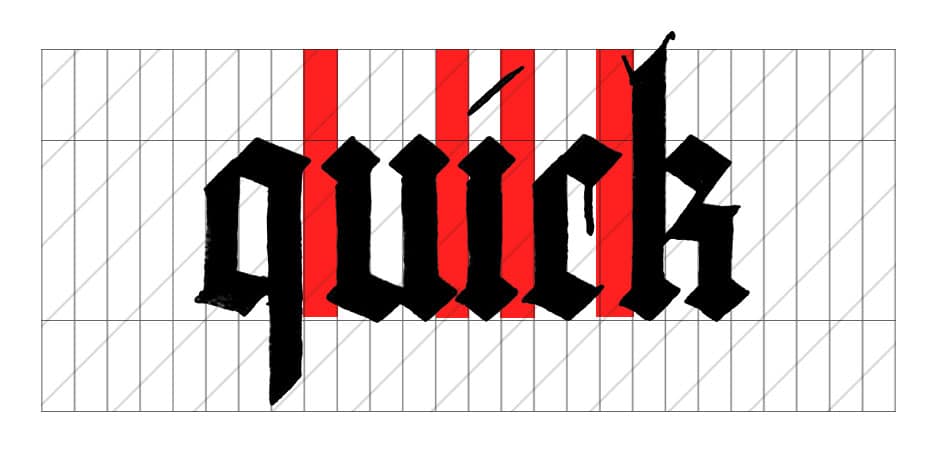
and one nib width of space inside of the letters, also known as the ‘counter’.
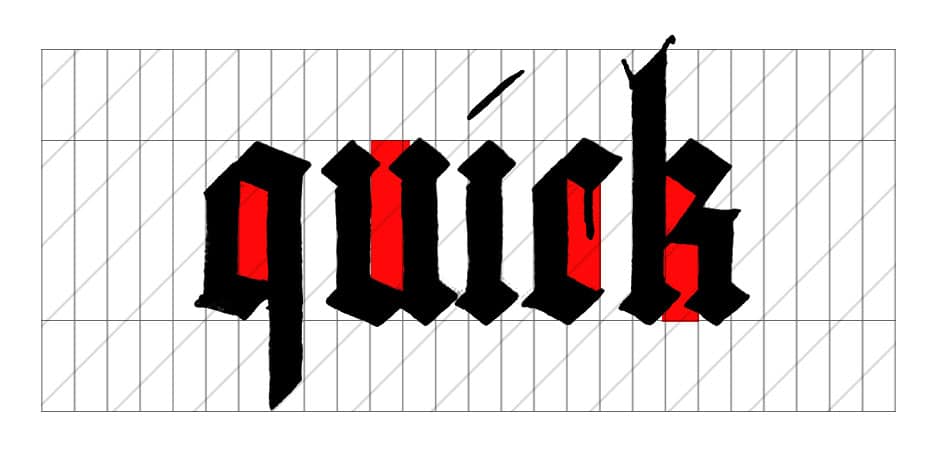
Word space should have 2 nib widths between.
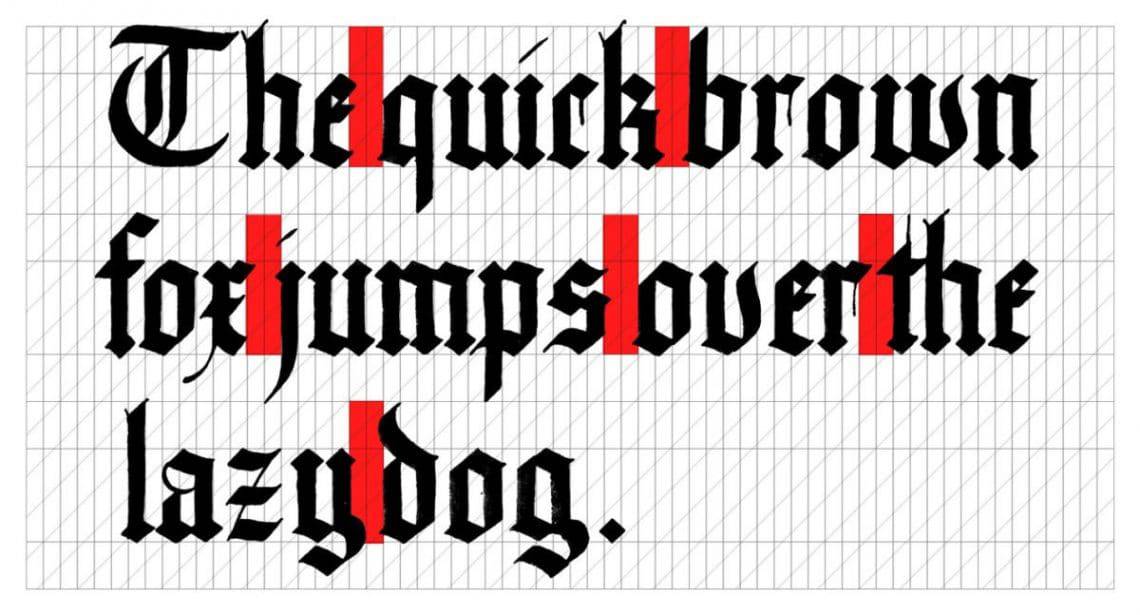
Give your letters style.
Once you get the hang of the basics, you can slowly start giving your letters some style. You can add what I call ‘spikes’ to the ascenders. This can be done using the edge of the nib.
You can make the spikes full and heavy
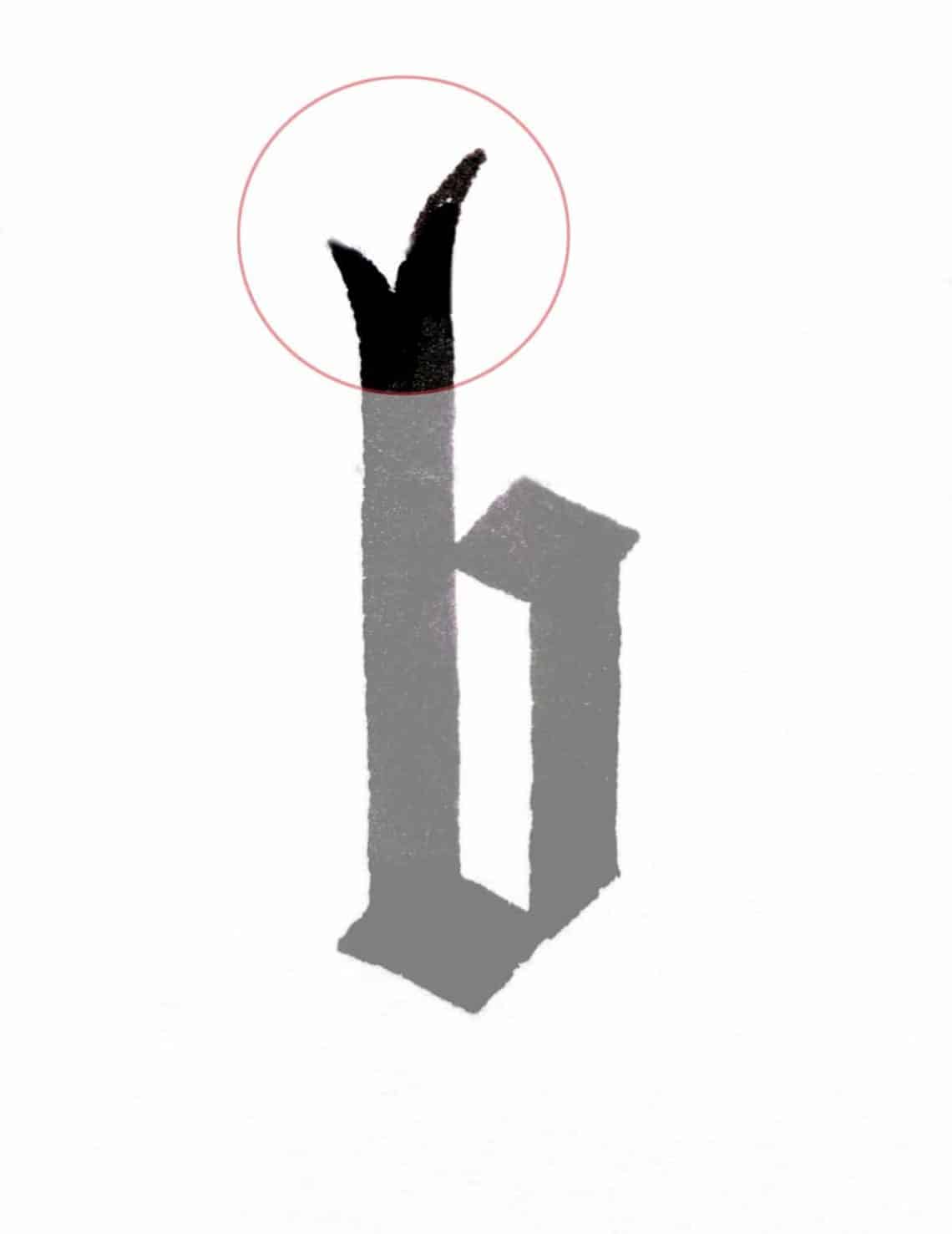
Or make hairline spikes. It’s up to you.
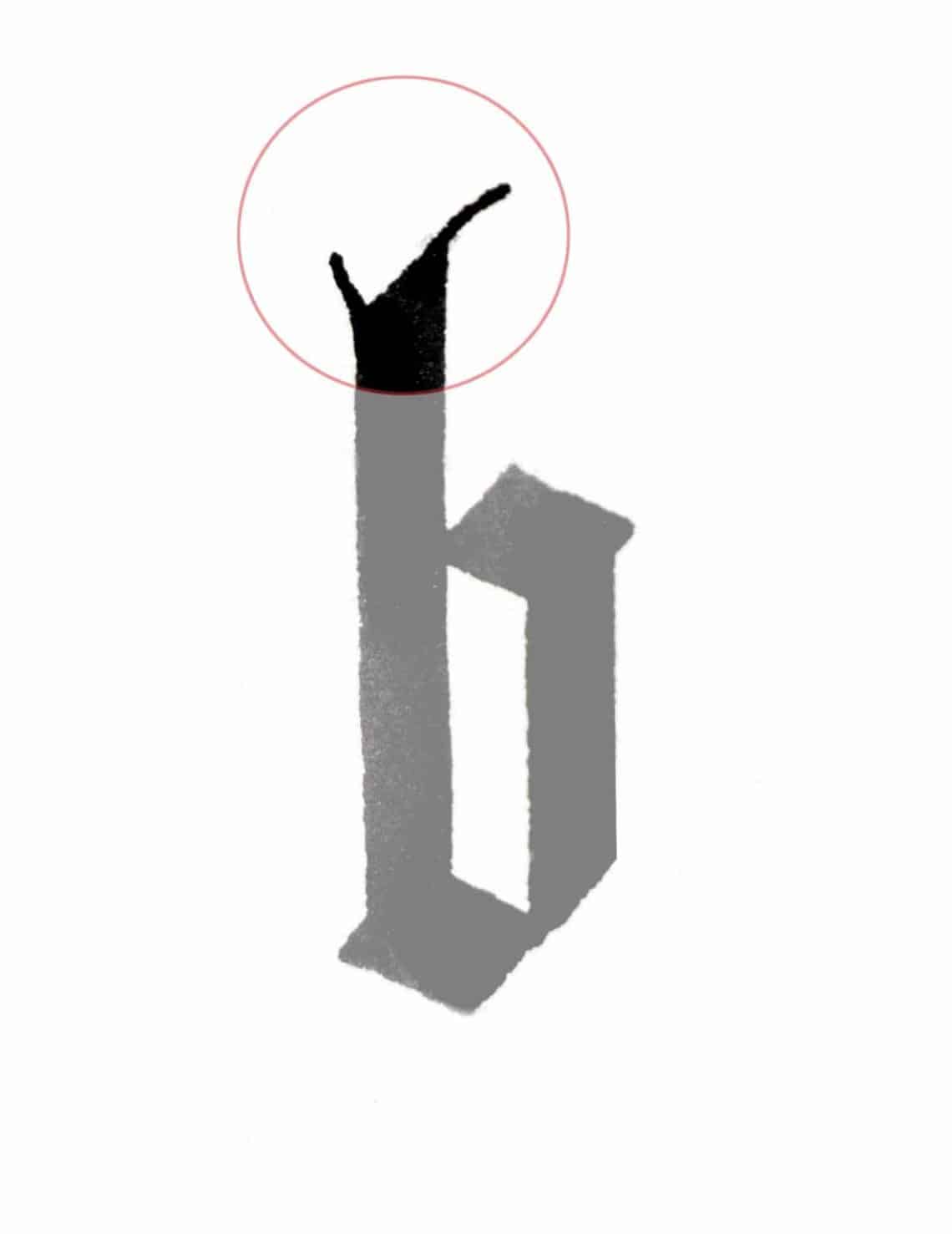
You can add some flourishes to your ascenders.
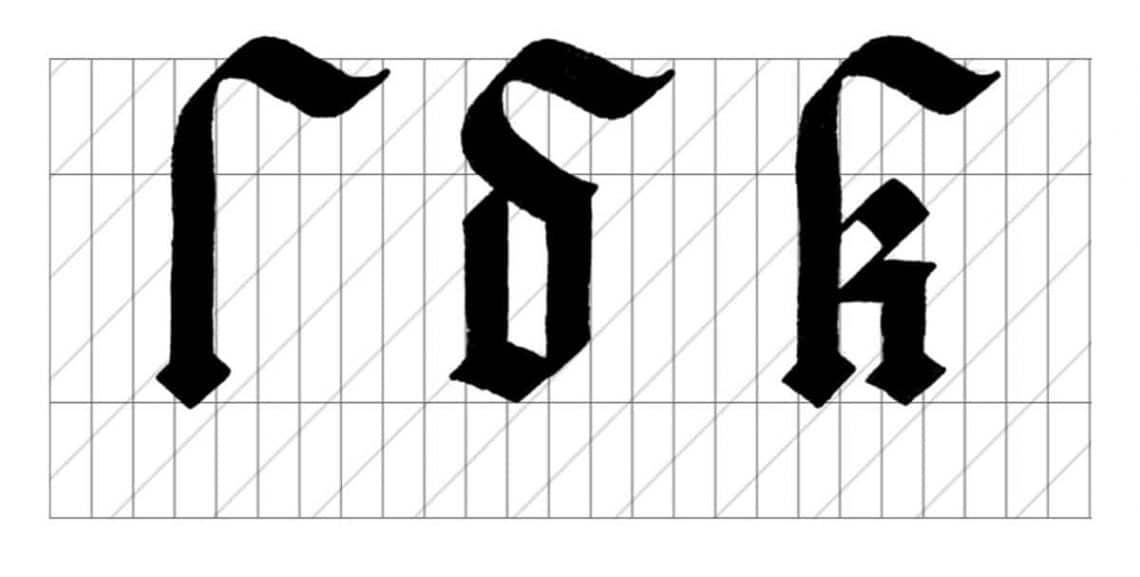
One step at a time
After you learn to construct letters, you can start manipulating your letters and extending your flourishes. In time you will create perfect letters and balanced flourishes.
Be VERY careful with that eraser.
When I am done and the ink is 100% dry, I will carefully erase the guidelines. I found that using a kneaded eraser will erase the guidelines with ease.
Always remember when using an eraser that you be very careful around any ink, even if it looks completely dry.
Remember to clean up when you are done. You don’t want to come back to a nib with dried-up ink, so clean it after every use.
Mistakes make you great.
I can’t tell you how many times I misspelled a word or had too much ink on the nib, which left a big blob to start from the beginning. It happens to the best of us, so don’t let that stop you.
Learning from your mistakes will help you grow and be a great calligrapher.
Is Blackletter right for you?
If your answer is yes, you can continue to improve your skills by downloading my FREE study guide. It will help you with forming basic letterforms for the Blackletter Textura Quadrata script.
If your answer is no, I would still suggest you download it and give it a try. Maybe it will be a start to a new interesting hobby.
Feel free to message me on Instagram if you have any questions. I always try my best to help out and respond to everyone. Also, if I don’t have an answer to a question, I will try and point you in the right direction.
Thank you so much for taking the time to read my Blackletter tutorial, and I hope you found it useful.
Drop your email below, follow the instructions, and get access to the worksheets.
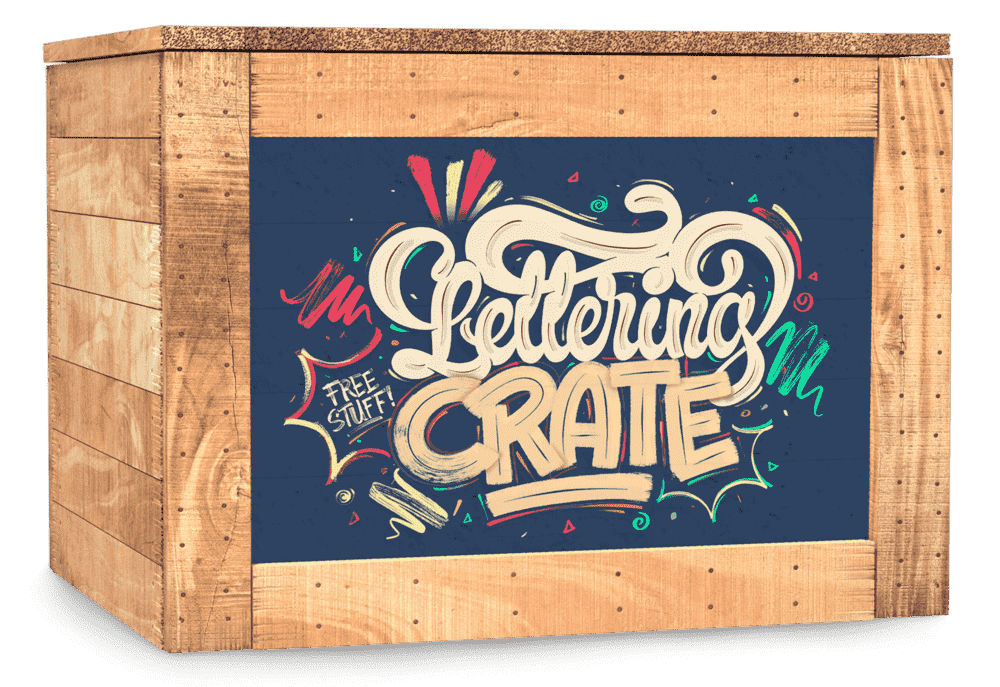
Stay updated with my tutorials and get instant access to the Lettering Crate –
A growing library of free lettering & calligraphy resources that includes –
You will also be able to download all of the other worksheets (and freebies) currently available in the Lettering Crate.
If you’re interested in learning some other styles, be sure to check out my article on the 10 calligraphy styles for beginners.
Hope this tutorial was helpful for you, and in case you have any questions, don’t hesitate to comment below.
Until the next one,
Stay AWESOME!
Pin me!
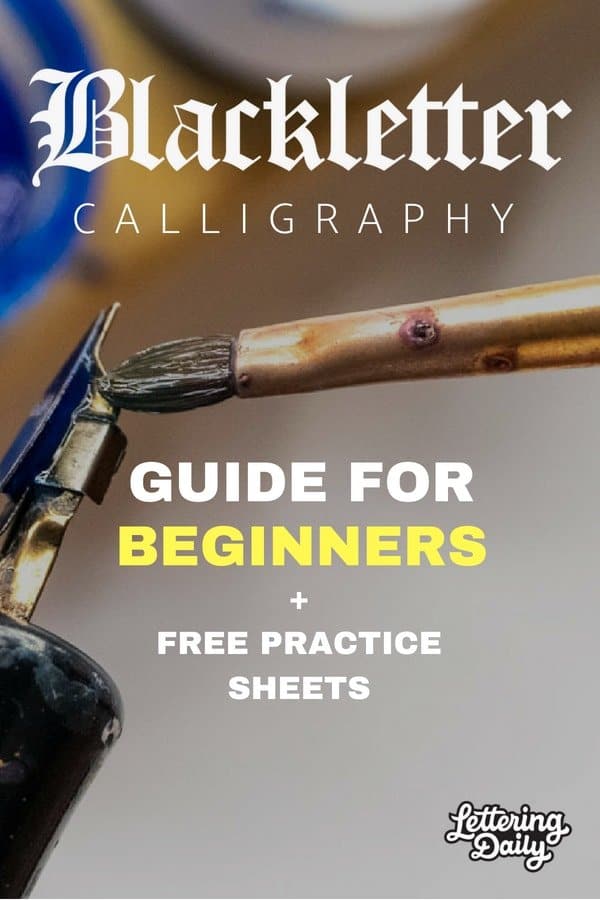
About the author

My name is Edgar Villa. A few of you may know me by my social media handle ‘Made by Edgar’ and I am a Mexican calligrapher/artist from Jersey City. I composed this article to help any beginners interested in learning ‘Blackletter’ calligraphy


Hi! Where could I get those practice sheets?
In the Lettering Crate, instructions are written above in the article.
I think the problem is that there is no blank practice sheet with just your slanted grid in the Blackletter set. Could you add one please?
For sure I’ll add it in the next update. Thanks for the feedback!
Please can i get some practice sheets. i am interested in learning.
All the worksheets and freebies are located inside the Lettering Crate. Sign up to the newsletter with your email and you’ll get instant access to the freebie page a.k.a – The Lettering Crate.
I wanna know the order of writing!
Can you show me?
It is so difficult…
I will soon update this article with a clear ductus of the whole alphabet! Sorry for the inconvenience.
Please , send me the worksheets. Thanks
I can’t send you the worksheets. They are all located inside the Lettering Crate. Just read the part in the article where the worksheets are being mentioned.
Heya!!!
First of all your tutorial & free downloadable worksheets are just amazing. I just wanted to know what’s the spacing between the vertical lines drawn or the width of it.
that she has used while making guidelines in the ratio 2:4:2.
Thank you
Thank you for your feedback! 🙂
I am interested in calligraphy and try to improve my skills in Black-Letter. Your practice guide sheets will be very helpful.
Thank you,
Vasfi
Hey Vasfi,
Glad to hear that, thank you for the kind words 🙂
Found everything, thank you. This tutorial article is great and the lettering gorgeous. Kudos!
Awesome! 🙂
I think many of your commenters are experiencing what I’m also encountering. I got the passcode and link. Perused your tutorials. I’m currently trying to find the Blackletter worksheets and any printed materials for download. There is a lot of great info here. But I have gotten to the comments section and still am unsure how to navigate to the downloads. I will take a closer look, as I’m sure it is there somewhere. But might I suggest that if so many ppl are finding it difficult to download your practice sheets, perhaps it’s not highlighted in a prominent enough way. I’ll begin looking again … thanks for all the learning materials!
Hello Violet. Thank you for your comment, and i completely agree with you. I will most definitely update the article and improve the structure so it’s easier for people to navigate. Constructive feedback is always super appreciated so feel free to drop your thoughts at any time 🙂
Wow! Thank you! I’m lookin forward to mastering this style
Hey Mary, thank you for your comment 🙂 Love the energy in your words, and if you need any help just let me know 🙂
Hi my email is
kulpreetk2304@gmail.com
Hello, Kulpreet. This does not work like this. I can’t use your email address. If you scroll above, you will see a sign up form. Drop your email there and you will get access to the Lettering Crate.
Please send free practice sheets. I am just starting out and found tutorial very helpful.
You got to sign up to the newsletter in order to get access to the Lettering Crate – once you do that you will have full access to all the freebies that we offer on the website 🙂
hi! i found this extremely helpful but where can i download the free practice sheets? thanks!
Hello Sam, thank you very much. Right before the end of the post there is a subtitle that says – Drop your email below so we can send you the FREE downloadable practice sheets. After that you just drop your email and we send you the access to the Lettering Crate where you can download all of the practice sheets and other freebies as well (it’s a resource library)
What about numbers and punctuation on blackletter?
Good question 😀 Im pretty sure you can find some inspiration on Pinterest
Can’t able to understand how I download the practice sheets!!!
Halo me for the same
Where exactly do you face the issue? How can i help?
Not sure if this is the same issues, but the confirmation email sends us to https://www.mailerlite.com/
Hey Aaron, we just tested the whole thing and it works without any issues on our side. Once you receive the confirmation email you just need to click on the big red button that says – ”confirm your email” after that you will get a second welcome email that will give you access to all of the practice sheets. In case you are struggling with it, please feel free to reach out via email and we can have a closer look at it.
I can believe it!! Just what I needed. I already have all the tools so I will start right away!! Thanks so much for sharing!!
Awesome! Great to hear that 🙂
hi! recently bought some parallel pens and it’s such great fun using them. learning blackletter and came across your site. it’s so useful! thanks~ been practising the letters, would you be uploading any symbols or numbers of the script? thanks!
Thanks for the kind words! Happy to hear that got started with the parallel pen – excellent choice!
As for your question i can suggest two things – 1. Send a message to Edgar on Instagram – he is really cool and always replies to the DM’s 2. Try to search on Pinterest for some inspiration.
Let me know if you have any more questions!
Such a well written and amazing article…each and every step was so amazingly explained…
Thank you! happy to hear that you found it useful 🙂
Thank you so much for sharing your work.really greatful to you guys?
Glad you enjoyed it! keep practicing and be sure to share your artwork 🙂
Thank you! this is so helpful.
You are welcome! 🙂
Thank you for sharing. This is awesome.
You are welcome! 🙂
Can’t wait to try this script…..thanks for sharing
Awesome! be sure to share your work on the forum, or use the #learning2gether to get some additional feedback on your work 🙂
Cheers!
Such a helpful post but not able to download the sheets..
Hey Saloni,
Glad you enjoyed the tutorial and im really sorry you couldn’t reach the practice sheets.
Would you mind describing where are you facing the issue? Perhaps you can take a screenshot and submit it to the forum under the ”other” section
or send us an email directly to letteringdaily@gmail.com
Looking forward to helping you out!
Thank You so much for generously sharing your knowledge with us newbies. ??
Super glad you found it useful! 🙂 Cheers!
This is very helpful. I have been looking for an easy to understand Blackletter guide. I appreciate the time and effort taken to make this and thanks for sharing it to the world ??
Thank you very much for sharing!!
You are welcome! glad you found it useful 🙂
WOW!! Thank you so much for sharing this! 😀 It was very helpful, and i can’t wait to start using these practice sheets 🙂